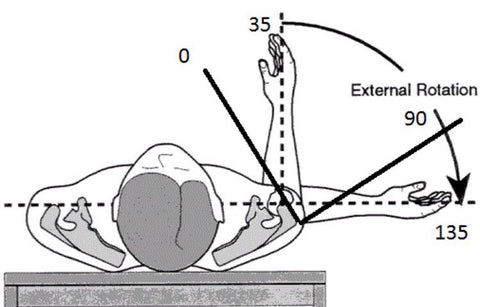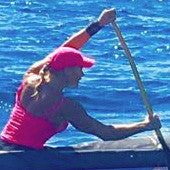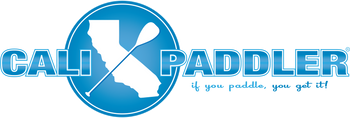 [ CP Fitness welcomes again Shanimal Fitness to help us find solutions for shoulder pain caused by impingement. Enjoy! -CP ]
[ CP Fitness welcomes again Shanimal Fitness to help us find solutions for shoulder pain caused by impingement. Enjoy! -CP ]
SHOULDER IMPINGEMENT
By, Shannon Hartnett (Exercise Physiologist)
Paddlers and athletes who have shoulder impingement a lot of times will have surgery to unhinge or release the shoulder. Shoulder impingement is when a paddler lifts the arm and the humerus bone impinges or pinches the rotator cuff muscles under the coracoarcromial arch. This can cause tears in the rotator cuff. Usually if you go to a surgeon they want to do surgery, that is their job. Basically, the surgeon destabilizes the shoulder by removing very important structures at the top of the shoulder. So you have a shoulder that no longer impinges, but is now unstable as this ligament holds the top of the shoulder bones together. This then sets up a new problem that also beats up the rotator cuff.
What happens with paddlers with shoulder impingement and muscle activation in this area is their upper trapezius muscle contracts too early and too much. This causes the scapular muscles give way too easily, which causes the impingement
We frequently see the upper trap muscle kick in excessively when the neck stabilizing muscles are weak, so the upper trap problem may also be caused by this secondary problem. Stabilizing the neck are deep cervical muscles that keep the neck bones perfectly aligned. They can go off track which causes the upper trap to help stabilize.
Many times what causes this is when someones posture is slouched, the chest rounds in, the shoulders round forward, the upper back hunches over, the shoulder blades (scapulas) rotate and tilt down and to the front. The increased curve causes the neck to crane out, causing the head to be held forward of the center of gravity and now you’ve placed your mid and upper traps in a disadvantageous position. Because of this your pectoralis minor is shortened and your serutus anterior is weakened as well. For each inch forward the weight of the head increases by 10 lbs. 2 inches an extra 20lbs. This causes the rhomboids, terres minor and traps to stay elongated and eventually the muscles turn off. Now that this has happened there is no stabilization for the scapulas to do any arm movement.

RELEASE TECHNIQUES
Here are some techniques to relax the traps and release the spasm.
1) Push against the end of an Olympic bar with the arm lifted to raise the teres major up to get to the teres minor underneath it exposed. Place your arm in a goal post position and push your hand and arm backwards.
Another way for a release is to get a PVC pipe. lay on your side, lift your arm to goal post position to expose the teres minor, which lies beneath the trees major and rotate your bent arm back. If you are not grimacing in pain, you on not on the teres minor.
2) After releasing the teres, stand under an olympic bar and push the bar down on the trap and begin a full range of motion with your arm to release the traps from my levator scapula and the cervical spine of the neck. These exercises cause the traps to calm down and allows the rhomboids to stop taking over.
3) Another good release exercise is to place your neck on a PVC pipe and bear down on it. Turn your head slowly left and right as far as possible while still pressing into the pipe. Then turn your head about one inch to the right and drive into the trap shaking your head yes and no to do some cross striation.
4) Place a DB in between your scapulas, press down and roll up and down along the blades, now bear hug yourself and that will pull out the muscles even more.
5) Lay with your traps of your neck on the PVC pipe, push down as hard as you can against the pipe. Rotate slowly left to right a couple times, then go as far as you can to the right and push your palm against your skull so you add additional pressure onto the next muscles, then do the same on the left. Go back to neutral and move you chin1 inch to the right, while pushing down on the pipe shake your head "yes" and "no" along the trapezius muscles.

EXERCISES
1) LAT RAISES WITH PINKIES UP
Make sure the DB are at your side, not slanted forward. Lift very slowly out of the hole and stop when your traps began to take over and raise up. Then move slowly down but stop about 6 inches from your legs. Make sure you move very slowly when starting the movement upward again. Always recheck and make sure your pinkies are forward.
2) CABLE ROWS
First start easy with cable rows. Make sure your back is flat, chin is up and pull your chest to the bar, don't cave your chest in. This exercise strengthens the rhomboids and middle and lower portions of the trapezius muscles and retract or pull the shoulder blades toward each other
3) DB EXTERNAL ROTATION
The paddler lies on their side with the arm bolted into ribs on top side. The elbow is bent so that the hand points towards the floor. Rotate the shoulder so that the hand moves up, towards the ceiling as far as possible and then slowly move it down keeping the elbow on ribs.
4) DB INTERNAL ROTATION
The internal rotation is the opposite movement. Still on your side have your forearm parallel to the ground. Keep your arm at a 90' and move upward toward your stomach, and then maintaining that position move it slowly down.

 Team Writer Shannon Hartnett - Shannon Hartnett has been a fitness trainer for over 20 years. She graduated from college in the fitness industry at Cal Poly SLO and at Sonoma State. Shannon also competed in basketball and track and field in college. Shannon was a professional athlete for 22 years and has spent a lot of time at the different Olympic Training Centers. Shannon has many specialized training certificates such as rehabilitation certification, kettle bells, TRX, MOR Bar and a Yoga instructor
Team Writer Shannon Hartnett - Shannon Hartnett has been a fitness trainer for over 20 years. She graduated from college in the fitness industry at Cal Poly SLO and at Sonoma State. Shannon also competed in basketball and track and field in college. Shannon was a professional athlete for 22 years and has spent a lot of time at the different Olympic Training Centers. Shannon has many specialized training certificates such as rehabilitation certification, kettle bells, TRX, MOR Bar and a Yoga instructor
In the last several years, Shannon began paddling, including Outrigger Canoe, and has raced throughout California and in Hawaii. Visit her website http://www.shanimalfitness.com for a chance to learn more about her fitness and nutrition business and talk paddling!
















Comments